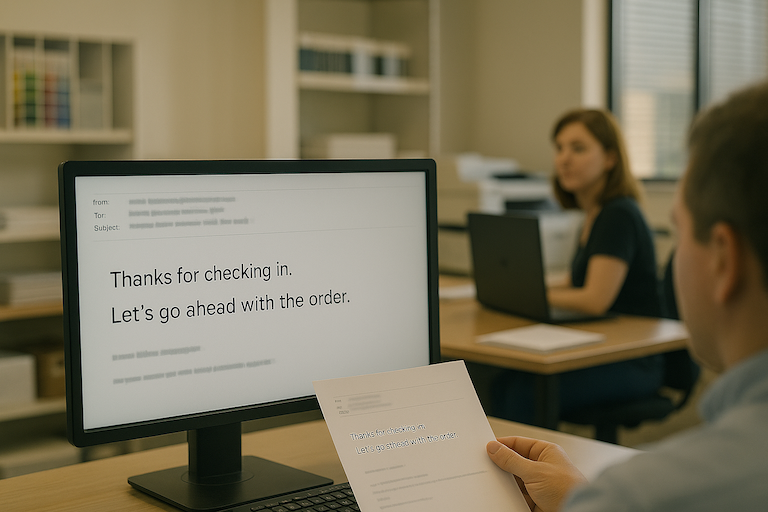Start small. Start safe. See what happens.
Clay’s not diving into the deep end. He’s not trying to overhaul his whole business. He’s just doing what I recommend every printer do when they’re curious about AI: start small, start safe, and see what happens.
Let’s continue with Part 3 of Clay’s story.
A blank screen and a blinking cursor
It was a quiet Saturday morning at Clay Morgan’s house. The shop was closed. His wife was out running errands. And Clay was sitting at the kitchen table, laptop open, coffee in hand.
He stared at the prompt box on a free AI tool he’d bookmarked weeks ago.
What am I even supposed to ask this thing?
He thought about the customer who had gone silent after receiving a quote for two, 4’x8’ signs. Nothing unusual. But still, it bothered him.
Okay, let’s keep it simple, he muttered, and typed:
“Write a follow-up email to a customer who hasn’t responded in two weeks.”

The tool responded almost instantly with a perfectly formatted email.
Dear Valued Customer, We hope this message finds you well…
Clay squinted at the screen.
I’d never send that.
It was professional, sure. But it didn’t sound like him. It sounded like someone playing business.
Prompt. Tweak. Repeat.
Clay adjusted the prompt:
“Write a follow-up email to a sign shop customer who asked for a quote two weeks ago and hasn’t replied.”
Better. AI included the phrase “just wanted to check in” and mentioned the original request.
But it still felt a little stiff. Too generic.
He tried one more version:
“Write a follow-up email to Jack, who requested a quote on two 4×8 corrugated signs. Make it friendly and casual. I’ve attached the quote so you can see what I sent to Jack. We gave him that quote, but haven’t heard back.”
The response this time made him pause.

Clay smiled. It was close. He changed “circling back” to “checking in,” added the customer’s business name, and removed the sentence about the schedule.
Now it sounded like him.
It’s not writing it for me, he realized. It’s helping me write it faster and better.
Trying something it can’t do
Feeling bold, Clay tried a different challenge. He asked the AI to generate a production schedule for the next week.
The result?
A color-coded outline that looked like something from a corporate textbook: “Assign daily roles for fulfillment,” “Confirm vendor timelines,” “Monitor progress.” Not wrong. But not helpful.
He closed the tab and shook his head.
Okay, so it’s not a miracle worker. That’s fine. I didn’t ask for one.
What mattered was this: he wasn’t afraid of it anymore. He was figuring out what it was and what it wasn’t.
One small win
Clay copied the AI-assisted email and sent it to Jack.
An hour later, he got a reply:
“Thanks for checking in. Let’s go ahead with the order.”
That was it. One prompt. One message. One win.
Later that afternoon, he mentioned it to Jess, his CSR.
“I used that AI thing this morning,” he said. “Helped me write a customer follow-up.”
She looked up from her screen.
“You’re using it now?”
“Just for little stuff,” he said. “It helped me write faster. Jack emailed back an hour later.”
“I don’t want this replacing my job,” she said.
“It’s not,” Clay said. “It’s making mine easier.”
Jess didn’t say much more. But she didn’t roll her eyes either. And that was enough.
Why Clay’s story matters
Clay’s story isn’t dramatic. He didn’t automate his business overnight. He didn’t build a custom workflow or launch a new department.
He just sent a better email.
Faster.
With less stress.
And when you’re running a print shop, where follow-up can be the difference between booked work and lost business, that’s no small thing.
Sometimes the best place to start isn’t with strategy or structure. It’s with one task you do every day that you’d love to do better.
That’s where AI starts to show its value.
Next month in the series
Clay invites his team into the AI conversation and learns what they’re really afraid of.



